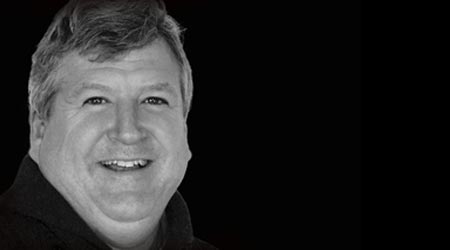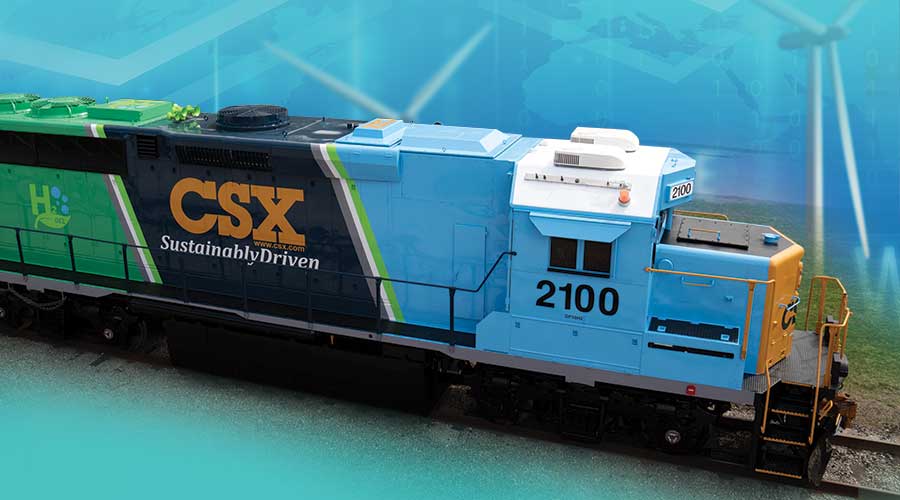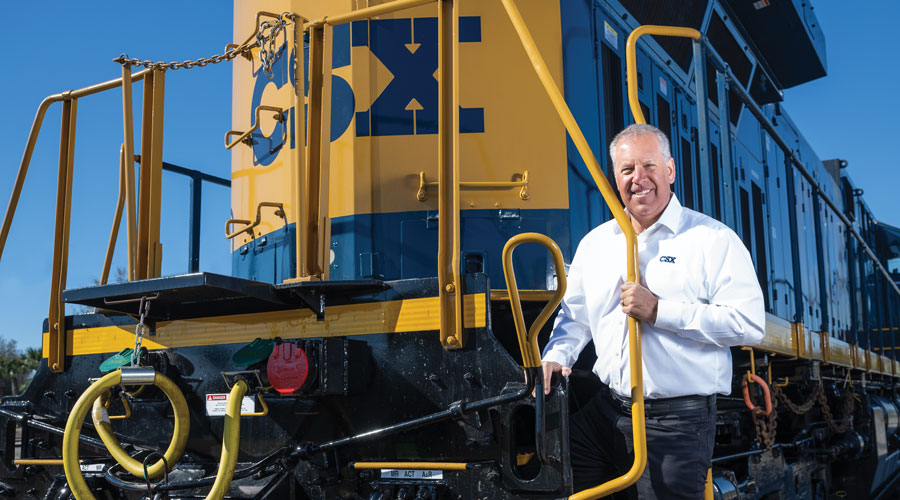Stay updated on news, articles and information for the rail industry
March 2018
Rail News: CSX Transportation
CSX update: Takeaways from the March 1 investor conference — analysis by Tony Hatch

CSX execs accomplished the most important thing they set out to do March 1 at the railroad's long-anticipated Investor & Analyst Conference in New York City. Having already scooped themselves by unveiling their big buyback program and unveiling their 60 percent — down over 600 basis points (bps) — operating ratio (OR) target for 2020, the CSX team revealed its management depth and competence, as well as its commitment to Precision Scheduled Railroading (PSR).
The house was packed, the coffee plentiful. The Show was good. The team was light on numbers (price goals, of course, but also volumes), but strong on process, belief and depth — and strong on the emergence at CSX of the “Post-Hunter” railroad, just as we have seen at CP and CN.
CSX has been described as dedicated yet segmented (often by predecessor railway), bureaucratic and change-averse, pre-PSR — but not today. It is much more streamlined, data-driven and integrated. Hopefully, this was done without too much collateral damage as we enter a new era. At the investor conference, CSX made a strong case for itself. And I am, if not yet fully convinced, a believer.
Jolly Good Show (less spectacular than the old days). It wasn’t perfect, and it did lack the pizzazz of the old Hunter/Elvis shows (Hunter-led presentations have involved bands, Apple products and even giraffes). Interestingly, each of the 12 speakers said something like “PSR — Precision Scheduled Railroading" … or "Scheduled Railroading" ... or are we seeing the beginning of re-branding? The day before the conference, a CSX employee and self-described “whistle-blower" sent out an eight-page screed to the financial community, full of bile, talking about the new, tough talk of the Hunter/Jim regime. New? In railroading? It also got mean and personal (calling out, for example, one of the speakers as being a meanie). But he (“Will Tell”) did bring up four things that, in retrospect, were not covered:
• Safety — Yeah, we started with a briefing, but that was the last time it came up, which is unusual for a railroad. The comments also suggested CSX had underspent on maintenance of way, which the numbers don’t back up.
• Long trains are a focus — It's often the case with DP (Distributed Power), but while long trains work on the western (and Canadian) long, flat hauls, do they work as well in the mountainous terrain of large swaths of CSX?
• While headcount reductions are a positive (to the Street, anyway), and “doing more with less” is a PSR mantra, are there enough “boots on the ground” (and clerks on the phone)?
• Morale — It's a good point and a question worth raising, but it's a really hard one to answer fully. The CSX folks in NYC, the 12 speakers and numerous others were united in their belief that the morale ship had been turned back in the right direction.
And although there were a few questions on technology (not nearly as many as on OR, unfortunately), this was an issue that wasn’t fully addressed (as compared with, say, CN’s investor conference in June 2017).
What I'd expected — and what I ultimately got — from The Big Event. The day before the conference, I listed the Top 10 things I was looking for. Here are the 10, plus what I heard on March 1:
1. What’s left to be done in the PSR transition (heavy lifting or light maintenance work?) CSX continued to state that the heavy lifting was done, but Chief Operating Officer Ed Harris and team stated that the trip plan process (critical to PSR and scheduling by rail car, as opposed to “train planning"); VP of Precision Scheduled Railroading Implementation Jamie Boychuk, under whose leadership yard conversion, CSX-system integration and trip planning falls, was a hit with the crowd.
2. Does CN’s well-publicized (overly publicized?) service issues mean, as an analyst (staggeringly) asked of them, that PSR is a one-trick pony? This question was always facetious — I don’t think it is true of CP or CN (to whom it was asked). CSX highlighted its service recovery, even claiming to be the best in North America at present ... which, unfortunately, isn’t as tough a comparison as it ought to be ... and a growth plan predicated on taking share in carload and intermodal that would require consistent and improving service.
3. How has CSX’s service recovery progressed? This is big. At the Southwest Association of Rail Shippers 2018 annual meeting in mid-February, CSX President and CEO Jim Foote said the railroad was fluid and essentially recovered from its self-imposed issues that began in the summer. He has spent the winter on his self-named “Apology Tour,” but said that it was over now: CSX “no longer has to apologize for its service." (!) CSX continuously stated that the summer of 2017 (“when Hunter bombed the network” with radical, rapid change) was an aberration, caused in part by “going too far too fast” that has been corrected. While not all were convinced, CSX velocity was up 30 percent from the summer doldrums and dwell was down 22 percent.
4. How has Norfolk Southern’s own service issues — and CSX’s recovery — impacted the rail competitive situation in the East/Southeast? Their growth expectations for intermodal, for example, suggest regaining share from the railway as well as the (troubled) highway, but CSX didn’t directly address the issue (as expected, if not hoped). But pricing looks positive from both perspectives, and the idea that revenues will accelerate over the three-year period from a slowish start this year (to achieve an overall 4 percent CAGR) even as expected economic growth actually follows the reverse pattern. Estimated GDP growth rate is expected to drop from +2.6 percent in 2018 to +1.9 percent in the election year of 2020, according to HIS) is also suggestive.
5. Who Ed and Jim have identified as “next-gen” CSX leaders (so far). PSR veteran Ed Harris discussed his long career, excluding his CSX advisory but mentioning his role with Rio Tinto in Australia (where I'll be the first couple weeks of March), the leader in driverless train technology application. No one as yet filling the chief marketing officer position (I have some ideas), but unlike the long period of PSR transition at CP, in this case, marketing is the CEO’s bailiwick. In terms of completing the operational transformation, the operations leadership team under Harris, who presented first, including Boychuk and VP of Strategic Planning Amy Rice and Chief Transportation Officer Jermaine Swafford (who said there was a “whole buffet” — the food kind, not Warren — “of opportunities still at CSX”) were sharp and exuded competence and confidence. One smart investor said that because of the Ops presentation, this was “the best CSX meeting he had seen in his decade plus of following the company. I concur.
6. What strategic decisions might be (or have been) re-thought (such as the Baltimore tunnel). The intermodal strategy will include Northwest Baltimore (Ohio), but not as originally envisaged as a “hub" as CSX has moved from a “H&S” strategy; line segments are under review (see below) and so is the decision not to expand the Baltimore tunnel. We’ll see on capex — the three-year average spend of $1.6 billion is down some $1.1 billion, or 40+ percent, of the 2016 level.
7. From VP of Industrial Products Michael Rutherford (he presented at RailTrends 2017) on how the industrial (car-load) products business will benefit from PSR (the “point of the spear”). Merchandise revenue three-year CAGR is 4 percent, ahead of GDP and at the company goal level, so that is something. Rutherford, as he outlined at RailTrends late last year (and at NEARS, among other conferences; he has been a road warrior on the Winter 2016-17 Apology Tour), said that his Merchandise unit is pivoting to growth, with 2018 the inflection year.
8. From VP of Intermodal Dean Piacente (RailTrends 2016) on what the new Intermodal strategy will look like — and the future of North Baltimore and the Harrison reversed hub-and-spoke strategy. Intermodal has shifted to a point-to-point strategy as mentioned before and above. Intermodal shed some 7 percent of its business in the PSR restructuring to date (and the changed strategy) and has already apparently made up that book of business. Its goal revenue CAGR of 8 percent is aggressive and doable —Intermodal growth will be helped by highway conditions and, perhaps, NS conditions, but be hindered by drayage driver shortage (the primary reason why intermodal dwell is suffering year-to-date industrywide). CSX's plan to ride the wave of future East Coast port market share into the Ohio valley is something that I am skeptical of — but I do like their plans to take more rail share (20 percent to 25 percent) of East Coast landings with offerings like Wilmington, North Carolina, to Charlotte.
Note: This (the Merchandise forecasted CAGR +4 percent, Intermodal +8 percent) implies that the third major commodity segment, coal, will grow below the 4 percent company target to 2020 — beginning with a flattish 2018 outlook, which may be optimistic. CSX expects a slight increase in its volatile export loadings and a less-sharp secular decline in its utility coal volumes. To that end, it has improved its cycle times by 20 percent and appears to be somewhat, er, “flexible” on coal pricing.
9. The extent and nature of the CSX short-line strategy — how realistic is the “8,000 miles under review” commentary; what are the actual segments and timing); there is a lot of money out there! By “a lot of money,” I'm referring to the huge pools of dry powder. CSX sees some $600 million — not in plan — if they sell some segments, including the two (Florida and Illinois) we know are “in process.” They stated that the rumor mill (“8,000 miles to be under review”) was inaccurate, though there were no direct corrections. VP of Strategic Planning Rice, who is in charge of this and other transformative strategic aims, is clearly thought of as a rising star. It was indeed nice to see the team show enthusiasm for their members and Rice fit the bill.
10. From CFO Frank (“Lone Survivor”) Lonegro on guidance (hopefully more longer term and little short term; and even more hopefully more on ROIC than OR!) Return on invested capital (ROIC) wasn’t mentioned, and this was my only real disappointment — I wasn't disappointed in Frank’s excellent, concise (maybe even “brief”) presentation, but in discussions around OR and FCF generation (not unimportant, to be sure), and not ROIC or some other measurement. CSX went to great pains to show that the capex reductions weren’t network muscle (but locomotives, rolling stock, positive train control as it evolves, and lapping some big projects such as the Virginia Avenue tunnel in D.C.). The railroad also brought full Ops teams to chat during the breaks in a reassuring way.
Keywords
Browse articles on CSX Jim Foote Precision Scheduled Railroading Tony HatchContact Progressive Railroading editorial staff.


 2025 MOW Spending Report: Passenger-rail programs
2025 MOW Spending Report: Passenger-rail programs
 Gardner steps down as Amtrak CEO
Gardner steps down as Amtrak CEO
 Guest comment: Oliver Wyman’s David Hunt
Guest comment: Oliver Wyman’s David Hunt
 Women of Influence in Rail eBook
Women of Influence in Rail eBook
 railPrime
railPrime






